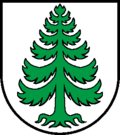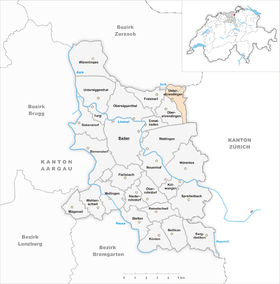Unterehrendingen
| Unterehrendingen | ||
|---|---|---|
| State : |
|
|
| Canton : |
|
|
| District : | to bathe | |
| Residential municipality : | Things of honor | |
| Postal code : | 5420 | |
| former BFS no. : | 4043 | |
| Coordinates : | 668 575 / 261 574 | |
| Height : | 444 m above sea level M. | |
| Residents: | 1657 (December 31, 2004) | |
|
Proportion of foreigners : (residents without citizenship ) |
- | |
| map | ||
|
|
||
Unterehrendingen is a village in the Swiss canton of Aargau . It belongs to the municipality Ehrendingen in the Baden district , is four kilometers northeast of the district capital and was an independent political municipality from 1825 until the merger with Oberehrendingen on January 1, 2006.
geography
The village lies in a cut in the terrain at the north foot of the camps . The incision, which runs roughly in a south-north direction, begins at the Höhtal, the 500-meter-high transition into the Limmat Valley and extends to the Surb Valley . The development has grown together seamlessly with that of Oberehrendingen and follows the village stream that rises on the Lägern. The foothills of the Siggenberg extend to the west . The area of the former municipality was 333 hectares .
history
Individual finds prove that the area north of the camps was already populated during the Neolithic and Bronze Ages. The village was first mentioned in 1040 as Aradingin . The name is of Alemannic origin and means "among the people of the Arinrat". Landowners in the High Middle Ages were u. a. the monasteries Einsiedeln , Wettingen and Sankt Blasien . In the course of time the Wettingen Monastery assumed a dominant position. With the name in Eredingen villa inferiori , the smaller Unterehrendingen is distinguished from the larger Oberehrendingen for the first time in a document from 1261. The rulers were the Habsburgs .
In 1415 the Swiss conquered Aargau and Ehrendingen was henceforth the capital of the district of the same name in the county of Baden , a common rule . Both the lower courts as well as the court rights were by the bailiff in Baden exercised. In March 1798 the French took Switzerland and proclaimed the Helvetic Republic . Ehrendingen was initially a municipality in the short-lived canton of Baden , from 1803 it belonged to the canton of Aargau.
In 1825 Ehrendingen was divided into the independent communities of Ober- and Unterehrendingen. In 1832 a fire raged in the village, which cremated the first schoolhouse and four other buildings. Until 1960 the population stagnated or even decreased slightly. But then, due to the proximity to Baden and Zurich , increased construction activity began and the population almost quadrupled. The village became a popular residential community and grew together with the neighboring Oberehrendingen. The two villages gradually developed a common identity and decided to reunite in 2003. On January 1, 2006, after an interruption of 181 years, the Ehrendingen community was re-established .
coat of arms
The blazon of the former municipal coat of arms reads: "Green fir torn in white." The first image of the fir appeared on the municipal seal in 1827. It was not until 1926 that the colors were assigned to the coat of arms. The reason for choosing this motif is unknown, because the municipal archive went up in flames during the village fire in 1832.
population
Population development:
| year | 1844 | 1900 | 1930 | 1950 | 1960 | 1970 | 1980 | 1990 | 2000 |
| Residents | 387 | 309 | 325 | 453 | 460 | 865 | 987 | 1361 | 1532 |
On December 31, 2004, a year before the merger, there were 1,657 people living in Unterehrendingen, the proportion of foreigners was 12.3%. At the 2000 census, 48.3% were Roman Catholic, 35.1% Reformed, and 2.2% Muslim; 1.2% belonged to other faiths. 92.9% named German as their main language, 1.3% Italian, 1.0% each English and French, 0.8% Albanian.
traffic
Unterehrendingen is on Kantonsstrasse 279 between Baden and the Surbtal. The village is accessed by two post bus lines that run from Baden train station to Döttingen and Kaiserstuhl . The train station in the neighboring community of Niederweningen is the terminus of a line of the Zurich S-Bahn . On weekends there is a night bus from Baden via Unterehrendingen and Klingnau to Bad Zurzach .
Attractions
literature
- Andreas Steigmeier : Unterehrendingen. In: Historical Lexicon of Switzerland .
- Peter Hoegger: The art monuments of the canton of Aargau . Ed .: Society for Swiss Art History . Volume VII: District of Baden II. Birkhäuser Verlag, Basel 1995, ISBN 3-909164-44-7 , p. 155-164 .
Individual evidence
- ↑ Population development in the municipalities of the Canton of Aargau since 1850. (Excel) In: Eidg. Volkszählung 2000. Statistics Aargau, 2001, archived from the original on October 8, 2018 ; accessed on June 18, 2019 .




